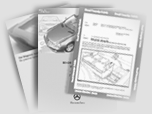
Diagnostic Manual, Chassis and Drivetrain,
Volume 2
Hydraulic Test Program - Preparation for Test
1. Connect the brake bleeder before beginning the test.
2. The hydraulic system must be depressurized before performing any work on the hydraulics. To do so, switch off the ignition. Slowly open the relief screw "SP" on the ABS/ASR hydraulic unit (A7/3) and allow the contents of the pressure reservoir to drain into a container for brake fluid.
3. After completing the test, first load the pressure reservoir (connect the ABS/ASR control module and start engine, let engine run until reservoir is full), then correct fluid level in brake fluid reservoir.
4.  1.0: the specific large tolerance in the pressure value (1.8 - 11 bar) is dependent on the manufacturing tolerances in the charging pump, ABS/ASR hydraulic unit and pressure reservoir check valve. 1.0: the specific large tolerance in the pressure value (1.8 - 11 bar) is dependent on the manufacturing tolerances in the charging pump, ABS/ASR hydraulic unit and pressure reservoir check valve.
5.  2.0 and 3.0: In the case of a defective return/pressure pump motor(A7/3m1), there will either be no build-up or too slow of a pressure build-up (max. 60 seconds). In the case of a defective pressure reservoir, the pressure build-up will occur quickly to values up to 50 bar and then proceed slowly up to maximium pressure or will occur quickly and steadily up to maximum pressure. 2.0 and 3.0: In the case of a defective return/pressure pump motor(A7/3m1), there will either be no build-up or too slow of a pressure build-up (max. 60 seconds). In the case of a defective pressure reservoir, the pressure build-up will occur quickly to values up to 50 bar and then proceed slowly up to maximium pressure or will occur quickly and steadily up to maximum pressure.
 WARNING! WARNING!
This system contains very high hydraulic pressures (250 - 3675 PSI).
Severe injury may occur if you come in contact with hydraulic fluid under pressures such as these. Be absolutely sure that the system is depressuized before loosening any fittings. |
 |
Conventional tools, test equipment
| Description |
Brand, model, etc. |
| Brake bleeder 1) |
Ammco model 7301 with adaptor no. 7309 |
| 1) Available through the MBUSA Standard Equipment Program. |
|


 Printable version
Printable version


 Printable version
Printable version